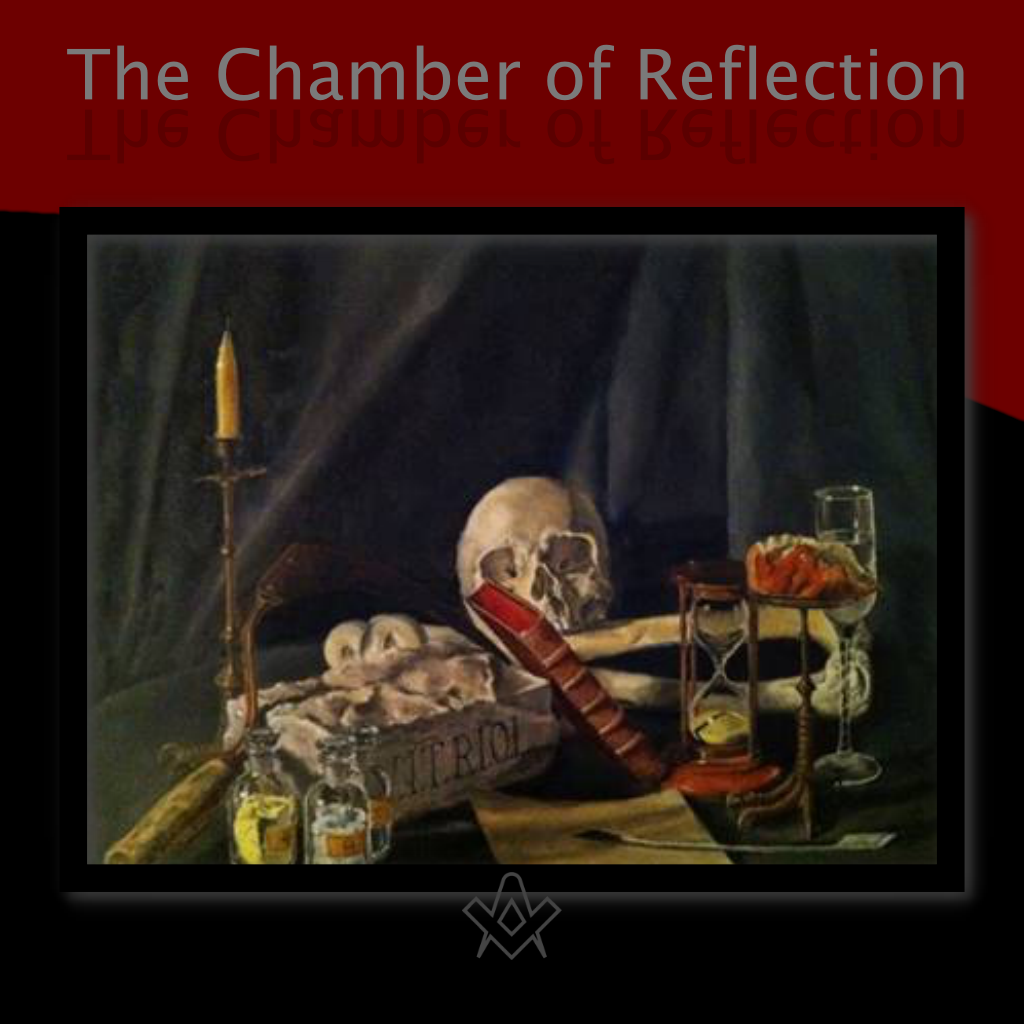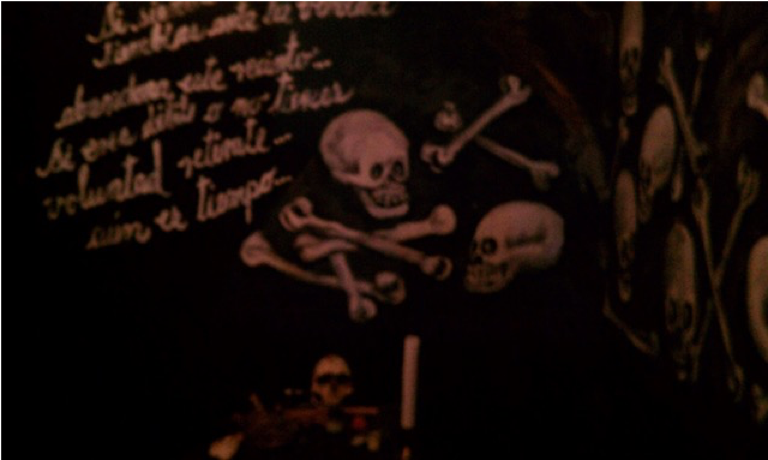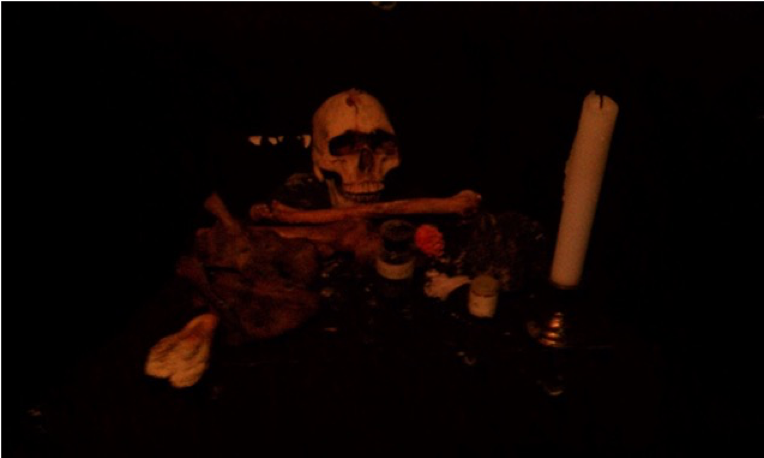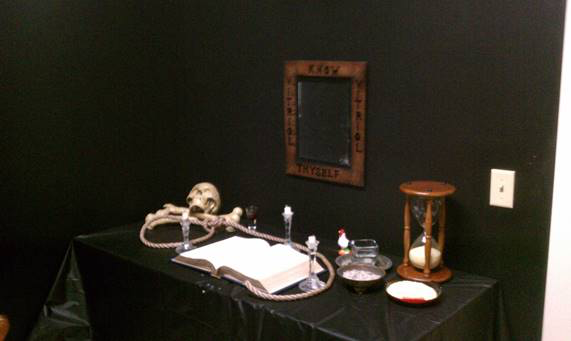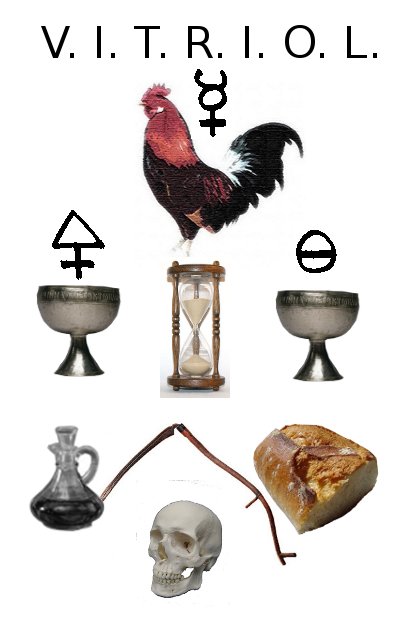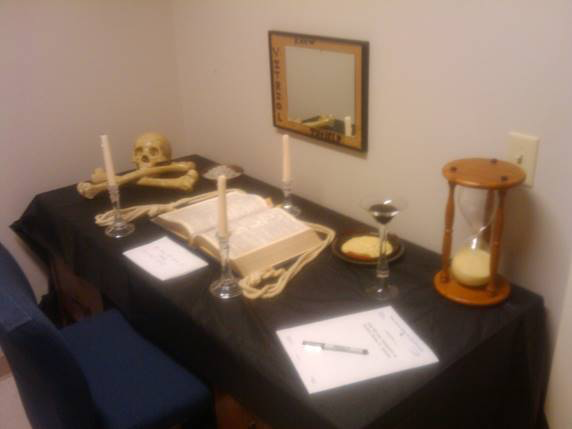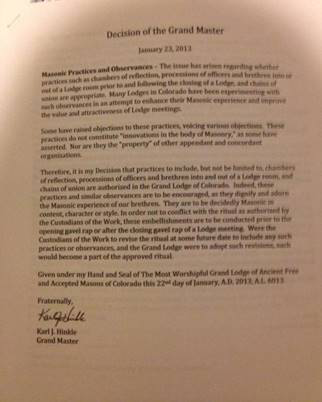The Chamber of Reflection is an amazing preparatory tool for the degree of Freemasonry.
Its history and existence date back to the very beginning, unfortunately most Masons have never heard of it.
The only place you will ever see it in American Freemasonry as an accepted practiced rite is in the Templar Orders. However, traditionally it was seen as early as the Entered Apprentice degree.
The main purpose of the Chamber is to help the candidate prepare himself for the solemn ceremonies he is about to undertake.
Today, the Chamber of Reflection would serve as an even bigger tool to make sure said ceremony stays solemn.
It would prevent members who chooses to haze or tease the candidate about riding a goat or other such clichés that are said.
This piece was originally published in the Transaction of Texas Lodge of Research, and later used in my book, The True Masonic Experience.
However, I was encouraged to publish this as a single book for those lodges who wish to have this readily available for their members. I hope you enjoy learning about one of the most misunderstood Masonic practices of our history.
Roberto M. Sanchez, 32° K\C\C\H\, K.Y.C.H
Past Master, Gray Lodge No. 329 A.F. & A.M. – Texas
Past Master, St Albans Lodge No. 1455 A.F. & A.M. – Texas
Past Grand Master, Gran Logia Estado de México
Originally published for the transactions of Texas Lodge of Research in 2013. In 2017 it was published independently as a booklet and then in that same year it became a chapter in The True Masonic Experience
The Chamber of Reflection: A Revitalized and Misunderstood Masonic Practice.
Copyright © 2013, 2017 by Roberto M. Sanchez
Feature Image: Chamber of Reflection Courtesy of Edolon House / The Joe and Jill Chronicles
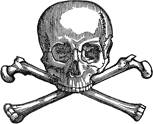
THE CHAMBER OF REFLECTION:
A REVITALIZED AND MISUNDERSTOOD MASONIC PRACTICE
Though the initiation rituals of Freemasonry are universal with slight variation according to various Grand Lodge jurisdiction, most American lodges fail to incorporate one of the oldest traditions utilized to prepare candidates through the use of the Chamber of Reflection.
Prior to 2009, the majority of Masons in the United States were unaware of the use of the Chamber of Reflection as an accepted preparation practice for the degrees.
The Chamber of Reflection was not a phrase common to pop culture, or even a part of American Freemasonry. However, thanks to author Dan Brown and his best-selling thriller The Lost Symbol, it has become a growing trend in many American Masonic lodges.
Those Freemasons who are members of the York Rite, more especially the Commandery, are tacitly familiar with the Chamber of Reflection.
Yet, even these degrees provide scant explanation in any of the rituals.
Somewhere in the transition towards a modern American society, the true intent of the Chamber of Reflection vanished into the mist of antiquity.
It is the purpose of this author to explore the history, protocol, and traditions of the Chamber of Reflection.
While traveling to several Grand jurisdictions in several different countries, I discovered that the Chamber of Reflection is very much alive where it has been continually practiced for years.
Most of the brethren who received their initiations in Europe, Mexico, Central and South America, the Middle East and Africa will be acquainted with the Chamber of Reflection.
Lastly, the practice may be found in the degrees in the Ancient and Accepted Scottish Rite, the French Rite, the Brazilian Rite and other rites derived from those listed.
In The Lost Symbol, a fictional thriller involving the Freemasons, Dan Brown introduces to the reader one of Freemasonry’s greatest initiatory tools – the Chamber of Reflection:
The skull sat atop a rickety wooden desk positioned against the rear wall of the chamber.
Two human leg bones sat beside the skull, along with a collection of other items that were meticulously arranged on the desk in shrine like fashion – an antique hourglass, a crystal flask, a candle, two saucers of pale powder, and a sheet of paper.
Propped against the wall beside the desk stood the fearsome shape of a long scythe, its curved blade as familiar as that of the grim reaper… ‘This room is Masonic?’ Sato demanded, turning from the skull and staring at Langdon in the darkness.
Langdon nodded calmly, ‘it’s called a Chamber of Reflection. These rooms are designed as cold, austere places in which a Mason can reflect on his own mortality.
By meditating on the inevitability of death, a Mason gains valuable perspective on the fleeting nature of life.
Dan Brown goes on to paint a vivid picture of the meaning of the Chamber of Reflection and lists items found in such a place.
But what did all of this mean to the Freemasons? How many American Freemason could actually identify the meaning of the items in this ‘secret room’? [1]
The Chamber of Reflection is not a new innovation but an ancient tradition older than the Craft itself.
In Freemasonry, the Chamber of Reflection was originally found in the French and Scottish Rites. This small room, usually adjacent to the lodge, is the predecessor of what Freemasons, commonly call the ‘anteroom.’
The purpose of the Chamber of Reflection is to give the candidate a chance to prepare himself for his initiation into the Fraternity. It is not just for the external preparation of the candidate, to put on the required garments, but for the internal mental preparation of the candidate.
The candidate is encouraged through self-reflection to contemplate what his motives are for joining the lodge.
The Chamber of Reflection is exactly what it implies, a quiet room where the candidate is to meditate before his initiation.
Isolation in this cavern-like room is where a symbolic metamorphosis is experienced, the neophyte emerges from this chamber symbolically transformed into a new person.
It serves to separate the candidate of all earthly things, his family, his job, the superfluities of daily life, and makes him consider the notions of his own mortality.
The Chamber of Reflection was intended to be the candidate’s very first experience in Masonry.
However, it is important to note that the Chamber of Reflection is a preparation tool, and not part of the degree itself. [2]
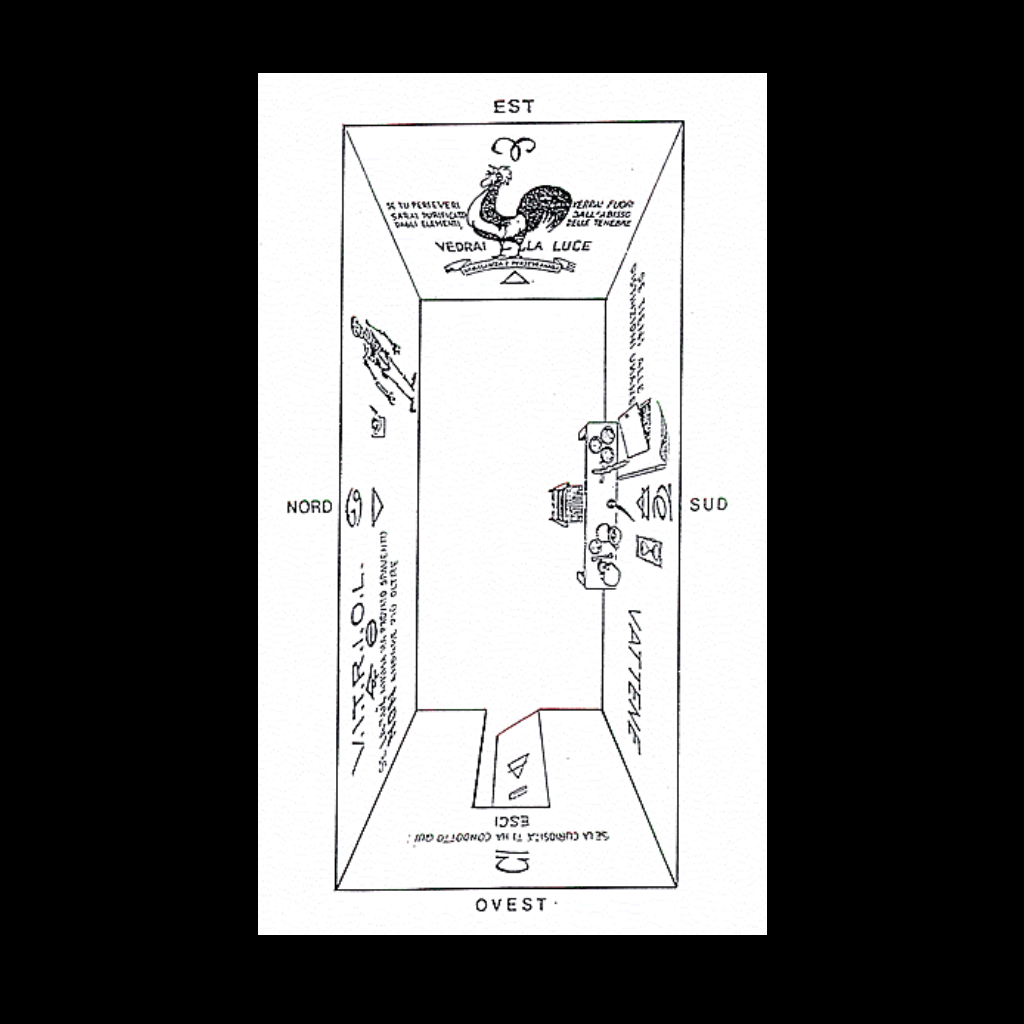
A diagram of a Chamber of Reflection
IMAGE LINKED: wikimedia Attribution 4.0 International (CC BY 4.0)
There are slight variations to the contents located within a Chamber of Reflection. For the context of this paper, the most common items as listed in the rituals of the French and Scottish Rite will be referenced.
According to Albert Pike, the Chamber of Reflection ‘should be one story below the lodge room; and if possible, underground, with no window.
The floor must, in any case, be of earth. On the walls should be brief sentences of morality, and maxims austere philosophy, written as if with charcoal.’ The room should be completely dark, and the walls painted black or made to look like the interior of a cave.
In the center of the room is placed a small wooden table, accompanied by a stool or uncomfortable wooden chair for the candidate to sit on.
On the table the following items should be sombrely placed: a single lit candle, a human skull and crossed tibia (leg bones), an hour-glass, a small bell, a small loaf of bread, a basin of water, containers of salt, sulphur, and mercury, a mirror, papers, a quill pen and ink.
In some chambers of reflection, there may be a picture or representation of a rooster instead of the mercury.
Lastly the alchemical cipher V.:I.:T.:R.:I.:O.:L.:, and the words ‘Know Thyself’ should be written somewhere on the wall. [3]
The emblems and relics found in a Chamber of Reflection all have a very specific significance.
Before expanding on these symbols, let us follow a candidate’s journey into the Chamber of Reflection on the day of his initiation into this tradition.
First the candidate, dressed in suitable lodge attire (dark suit and tie) is brought to the lodge building by his sponsor.
He must not meet any of the other Mason except the ones necessary. The Secretary and the Master of Ceremonies, (an officer who in some jurisdictions would be equivalent to the First Expert,) both dressed without any Masonic insignia, meet the candidate.
The Secretary collects the necessary fees and returns to the lodge room. The Master of Ceremonies stays with the candidate, while the sponsor also goes into the lodge room.
The Master of Ceremonies then blindfolds the candidate and introduces him into the Chamber of Reflection.
He presents the candidate with a piece of paper with questions that the candidate must answer.
The Master of Ceremonies indicates to the candidate that he must write on the paper his moral and philosophical testament.
He then instructs the candidate that when he has finished this task, he should ring the bell, or give three knocks to acknowledge that he is ready to proceed with the rest of the initiation.
He is also told that, once the door is closed, he should remove the hoodwink. At that time, the candidate sees the chamber and the objects described earlier. [4]
The Chamber of Reflection is an important symbol. It represents a womblike state, where the aspirant is to participate in his rebirth as an initiate, to indicate when the candidate emerges from the chamber, in the same manner as being born a new man.
Thus, the chamber indicates at the same time, a beginning and an end.
The end of the candidate’s life as a profane, and the beginning of a new life as an initiate in search of more light.
According to Andrew Hammer, in his book Observing the Craft,
Before ever knocking at the door of the Craft, the initiate was confronted with the gravity of his choice to join, so that any doubts he might have entertained could be acted upon.
In this way he might be spared a commitment he has not truly resolved to make, and the Lodge spared a man who would not endure even the test of confronting himself, much less having the resolve to better that which he had confronted.
He is put in darkness and isolation because both of these things together decrease the perception of time, and make a relatively short period of time seem much longer.
Thus, when the initiate arrives at the door of a Lodge, he has, to mind, long been in darkness.
This is the beginning of the journey for each candidate as they embark into the mystical and dramatic realm of Freemasonry.
It is at this point the candidate stands at the threshold of initiation where he may turn back.
Yet, if he chooses to proceed his life will be forever transformed. If the candidate fails to progress through the work of the remaining degrees, by their experiences in the outer chamber will force them to reflect upon their reason for wishing to become a Mason, and as such, for all their actions in life. [5]
A Chamber of Reflection in Mexico
IMAGE LINKED: authors private collection
The most misunderstood emblem is the skull. For centuries many non-masons and some persons within the Fraternity believed the skull to be an immoral and malicious symbol.
It represented a malevolent and evil nature, such as poison or danger.
But in the Chamber of Reflection, as in the rest of Masonry, that is not the case. The skull has appeared for centuries in various Masonic degrees, tracing boards, and aprons, such as the nineteenth century Knight Templar apron.
The skull, together with the crossbones, is a symbol of mortality, and is used to elaborate on the other symbols present in the chamber.
Its’ purpose is to serve as a reminder of the Latin phrase memento mori, ‘remember, you will die.’
It serves as a reminder that our earthly life is not eternal and your time spent on this earth is limited and should be spent to improve society, yourself, and your spiritual service.
Death is eminent, and each of us at one point or another must face this ultimate ending. [6]
Hourglass – Theatrum anatomicum / novis figuris aeneis illustratum, et in lucem emissum opera et sumptibus Theodori de Bry.
IMAGE LINKED: wellcome collection Attribution 4.0 International (CC BY 4.0)
The hourglass is an emblem of human life and represents the passing or marking of time.
It symbolizes the futility of attempting to stop or to slow down time.
As the candidate watches the slowly falling sands running through the hourglass so too does his time slowly runs out to death.
The hourglass elaborates on the solemn thought of death and reminds the candidate of the fleeting nature of his mortality.
Together the skull, the hourglass alludes to mortality and reminds the future Mason to make good use of his short time on Earth. [7]
The bread and water represent the bare necessities of life and are humble emblems of sustenance and simplicity.
Bread, considered one of the most meager forms of nourishment, reminds the candidate to live his life plainly, simply, and humbly.
Water is one of the four elements essential to the ancient mysteries, and is also an emblem of purity, or cleansing.
In some variations of the Chamber of Reflection, the candidate is required to wash his hands as a symbol of the purity of his intentions. [8]
A Chamber of Reflection in Mexico
IMAGE LINKED: authors private collection
The burning candle and bell lack some of the esoteric significance attached to the other emblems but are also important.
The bell is rarely used since it takes up space on the small table used in the Chamber of Reflection. Its sole purpose is to inform the Master of Ceremonies, or the Mason in charge of the candidate while he is in the chamber, that the candidate is ready for the degree.
Most common the candidate knocking three times on the door, has replaced the bell at the completion of his mental preparation.
The single burning candle primarily serves to provide the candidate with suitable lighting so he may perform the assigned task, whether it be writing his philosophical last will and testament, required questions or thoughts, all depending on the Masonic jurisdiction, or practiced Masonic rite. [9]
There are several items associated with alchemy in the Chamber of Reflection.
To begin the ultimate goal of an alchemist was to turn a crude and superfluous metal into a prosperous and valuable metal such as transforming lead into gold.
In the Chamber of Reflection, the alchemical elements are there to represent a different transformation, that of transforming the petitioner into a candidate.
These alchemical elements are salt, sulfur and mercury.
Salt alludes to several uses, but in the alchemical sense it alludes to the human soul.
Salt is a preservative, and reminds the candidate that his activities while on earth should be remembered in a positive manner even after death.
Salt, in excess may also spoil the food it was intended to preserve and admonishes the candidate to moderate his desires and passions. [10]
A three headed monster in an alchemical flask, representing the composition of the alchemical philosopher’s stone: salt, sulphur, and mercury. Watercolour painting
IMAGE LINKED: wellcome collection Attribution 4.0 International (CC BY 4.0)
Sulfur refers to the human body since some forms of sulfur are found in hair and skin. It is also a mindful reminder that all trials come to pass.
Just as the foul odor of the sulfur will dissipate over time, so shall any trials and tribulations the candidate may encounter. It serves as a lesson, and reminds the candidate to make all things a learning experience.
The coupling of salt and sulphur are the equivalent of the checkered pavement.
It represents that of ambivalence and balance of light and darkness, truth and error, life and death, soul and body. [11]
Mercury deity from The Surgeon’s Mate.
IMAGE LINKED: wellcome collection Attribution 4.0 International (CC BY 4.0)
Mercury may appear in the Chamber of Reflection as the element itself, or it may be symbolically represented as a rooster or cockerel, either painted or as a ceramic figurine.
The rooster is a symbol for the Greek god Hermes, or the Roman god Mercury, who crows at the dawn of day announcing the coming of light.
This alludes to vigilance and also corresponds with faith. Mercury is a symbol of the emergence of the darkness of ignorance and fear.
It is also the omen foretelling spiritual trial and testing.
Just as we need vigilance and perseverance to seek truth and the light, we must also have the courage to acknowledge it when our social standing, ego, and perception from others challenge it.
Mercury, salt, and sulfur, together, allude to the makeup of man and all substances.
These three symbolic elements derive from alchemy, a tradition which has provided us with all of the symbols we use today to describe a metamorphosis, thereby alluding to a lesson the candidate will learn in the first degree—to circumscribe his desires and keep his passions in due bounds. [12]
A Chamber of Reflection in the USA
IMAGE LINKED: authors private collection
The quill pen and paper are placed in the Chamber of Reflection for the candidate to perform his appointed task of writing as he is instructed.
Depending upon the particular Rite or degree, the candidate is asked to compose a short piece of writing. Most common, however, the candidate is encouraged to write reasons for petitioning for the degrees, or, in some lodges, his moral and philosophical last will and testament.
Since the candidate is confronted with the thoughts of his own mortality, he is asked to put into writing where all of his worldly belongings and legacy would go in case of his ultimate demise.
In some variations, specifically in the advanced degrees of the York Rite, there is a Bible on the table, and the candidate is asked to read the verse or verses associated with the degree.
In the Brazilian Rite, the candidate receives yet another task in addition to the ones already mentioned. He is presented with Articles I and II of the Constitution of the respective Jurisdiction.
The candidate must then sign and declare to affirm solidarity and act accordingly to the principles of Freemasonry. In some of the lodges around the world, where the Chamber of Reflection is used, it is customary to invite the initiate back into the Chamber of Reflection on his fifth-year anniversary of his initiation.
He then is presented with the same emblems he saw before his initiation, but now he is also presented with his philosophical and moral last will and testament.
The purpose of this exercise is for the initiate to reflect on his initiation, and see how far he has come and transformed over the years.
This practice may be repeated on different Masonic anniversaries. In all, this portion of the Chamber of Reflection allows the candidate a chance to reconsider his request for membership.
If his motives are not pure, if he is fearful and does not have the courage to proceed, then he may not be able to inviolate the secrets of Freemasonry. [13]
VITRIOL – Some of the symbols used in the Masonic Chamber of Reflection By Fiddlersmouth
IMAGE LINKED: wikimedia Attribution 4.0 International (CC BY 4.0)
The alchemical cipher V.:I.:T.:R.:I.:O.:L.: is an important element in some versions of the Chamber of Reflection.
It is an acronym for the Latin phrase Visita Interiora Terrae Rectificando Invenies Occultum Lapidem, which means, ‘Visit the interior of the Earth, and by rectifying, you shall find the hidden stone.’
Sometimes this acronym appears with the addition of U.:M.: at the end, signifying, Veram Medicinam, which means the ‘true medicine’.
As previously mentioned, the alchemist’s goal was to change base metals into gold, and the acronym vitriol was the recipe that would ultimately produce such a transformation.
However, in Masonry, the term vitriol is used as a tool to remind the candidate to look within himself.
Thus, using his time in this solemn chamber to reflect and examine his own life, and therefore search for ways in which he could improve himself internally.
Its ultimate goal is to have the candidate reach a sense of self attainment thereby understanding the other saying that should be written in the chamber — Know Thyself.
The candidate is to take this advice metaphorically. The meaning conveyed is that one must search within oneself, as the truth is hidden there, and this truth is the real solution to life’s problems. [14]
The mirror is essential to the Chamber of Reflection, because the purpose of this portion of the initiation process is to allow the candidate to reflect.
He is also to reflect on his own mortality, the reasons he has chosen to join the Craft, and to contemplate his own understanding of himself.
According to the lecture in the Third Degree, we are taught that Hiram Abiff repaired to the Holy of Holies to reflect upon the work he had accomplished, to meditate and pray.
It is in the Chamber of Reflection where the candidate gets a chance to practice the teachings of the Craft as they are intended, and emulate our ancient patron.
Another example of reflection and looking within oneself is portrayed in the Rectified Scottish Rite.
When the candidate is brought to light in the first degree, and the hoodwink is removed, the first thing he sees are the brethren looking back at him.
It is at this point the Worshipful Master informs him that:
‘It is not always before oneself, that one finds his enemies. That which is to be feared the most is many times behind himself. Turn around!’
It is at this time that the candidate is once again presented with the mirror and sees his own reflection.
It is a lesson by which the candidate is taught that the enemy is usually within oneself.
Therefore, each member of the Craft should know and scrutinize himself in order to break off the rough and superfluous parts of his life in order to live the life of a true follower of the Craft.
Thus, the Chamber of Reflection allows the candidate the chance to truly analyze and examine himself and the symbols in the room around him. [15]
The symbols, elements, and lessons within the Chamber of Reflection are provided for the specific purpose of allowing the candidate to meditate, reflect and contemplate.
None of the emblems should ever be used to frighten, haze, tease, or humiliate the candidate in any way.
The purpose of the Chamber of Reflection and its symbolic elements are meant to illustrate to the initiate that the ceremony of initiation is not to be taken lightly. [16]
A Chamber of Reflection in the USA
IMAGE LINKED: authors private collection
But what does all of this mean to the American Mason?
Where did the Chamber of Reflection go and why is it experiencing a revival in American Freemasonry?
The earliest English reference to a Chamber of Reflection seems to be in Jachin and Boaz, the English exposure of the ritual of the Ancient’s Grand Lodge, published in 1762.
Its description strongly resembles that of the one in the French exposure, Les Secrets de Francs- Maçons, published in 1742.
In Jachin and Boaz the chamber of reflection process is explained as follows:
Soon after, the Master asks if the Gentleman proposed last Lodge-Night is ready to be made; and on being answered in the Affirmative, he orders the Wardens to go out and prepare the Person, who is generally waiting in a Room at some Distance from the Lodge-Room, by himself, being left there by his Friend who proposed him.
He is conducted into another Room, which is totally dark; and then asked, whether he is conscious of having the Vocation necessary to be received?
On answering, yes, he is asked his Name, Surname, and Profession. When he has answered these Questions, whatever he has about him made of Metal is taken off, as Buckles, Buttons, Rings, Boxes, and even the Money in his pocket taken away.
Then they make him uncover his Right Knee, and put his Left Foot with his Shoe on, into a Slipper; hoodwink him with a Handkerchief, and leave him to his Reflection for about half an Hour.
The Chamber is also guarded within and without, by some of the Brethren, who have drawn Swords in their Hands, to keep off all Strangers, in case any should dare approach.
The Person who proposed the Candidate stays in the Room with him; but they are not permitted to ask any Questions, or converse together.
The idea of the Chamber of Reflection, as part of Masonic practice, also spread to Germany, Belgium, Holland, and other European countries. Between 1787 and 1801, Friedrich Ludwig Schröder worked on a revision of the German ritual based on Jachin and Boaz entitled Schroedersches Lehrlingritual.
It was accepted and worked in a number of German lodges, although other versions of the ritual continued to be practiced. [17]
Friedrich Ludwig Schröder (1744-1816)
IMAGE LINKED: wikimedia Attribution 4.0 International (CC BY 4.0)
In the early 1800s, the Chamber of Reflection was being used and practiced in several craft lodges in the United States.
By 1814, the Chamber of Reflection had made its way into the rituals of the Grand Encampment of New York, and by 1816, to General Grand Encampment at its formation.
The Chamber of Reflection was a well understood and a well-practiced Masonic custom in the United States at this epoch of its history.
Some Freemasons even had small chambers of reflections in their homes, while others would make it a habit to revisit the one they used during their initiation into the Craft.
All of this began to change by 1826, the year that America’s most notorious incident involving the Freemasons took place — the Morgan Affair. [18]
William Morgan – By A. Cooley – The Grand Lodge of British Columbia and Yukon: William Morgan – By A. Cooley – The Grand Lodge of British Columbia and Yukon: William Morgan notes
IMAGE LINKED: wikimedia Attribution 4.0 International (CC BY 4.0)
Captain William Morgan, a disgruntled Mason, announced plans to publish the rituals of Freemasonry.
Although a number of other ritual exposures had been published in the United States during the previous century, Masons were outraged that their secrets would be divulged to the community.
On 11 September 1826, William Morgan was arrested and jailed for an outstanding debt. The next day four Masons paid the debt, bailed Morgan out of jail and escorted him to a waiting carriage.
He was driven away and was never seen again. This event fuelled outrage among anti-Masons in the United States and gave birth to the Anti-Masonic political movement.
Because of the Anti-Masonic movement, Freemasonry was forced to adapt and change. The laws of several grand jurisdictions were changed, and the old custom of having to be invited or ‘tapped’ to join Masonry were forever changed.
Several hundred lodges in the United States closed its doors. New York went from 480 lodges in 1826 to 75 in 1835; Massachusetts dropped from 180 Lodges to 56, and the Grand Lodge of Vermont completely went out of existence.
Masonry experienced a transformation of a very exclusive and esoteric fraternity, to that of an open revolving door and transparent fraternity.
The more esoteric traditions retreated from the craft lodge into the higher invitational bodies, while the rites and traditions of the craft lodge rituals were diluted or completely abandoned, like that of the Chamber of Reflection. [19]
According to Masonic researchers and authors S. Brent Morris and Arturo de Hoyos in their book Committed to the Flames, in 1826, after the Morgan Affair, Robert Benjamin Folger filled a book with the enciphered craft rituals of a secret Masonic Rite.
These rituals were that of the Rectified Scottish Rite, also known as the Knights Beneficent of the Holy City or CBCS.
This order was well known throughout Europe but completely unknown in the United States at the time.
The Chamber of Reflection resurrected itself in the United States in rituals such as the Rectified Scottish Rite, but never really returned into mainstream craft lodges until the end of the twentieth century. [20]
Masonry has been forced to adapt and change in order to survive, such as the creation of Masonic fraternal organizations like the Shrine and Grotto, to family-oriented ones such as the Order of DeMolay, and Rainbow Girls.
Based on the information presented in this paper, chambers of reflection are gaining in popularity again because the younger Masons who are joining lodges today are very interested in the ancient mysteries of the Masonic Orders, and its old traditions.
Organizations like the Masonic Restoration Foundation have been created for the purpose of restoring some of these once forgotten Masonic traditions, while at the same time regulating the customs so they will not be done incorrectly.
Several grand lodges have adopted a number these customs and traditions in order to regulate them.
In a grand master’s decision issued 23 January 2013, the Grand Master of Colorado approved the Masonic practices and observances of chambers of reflection, officers processions, and chains of union. [21]
Grand Masters of Colorado Decision on Chambers of Reflection
IMAGE LINKED: authors private collection
Over the past several years, there have been several articles written about the Chamber of Reflection with no real research behind them.
There are several lodges using chambers of reflection with the goal of scaring the candidate, or doing it because it is a ‘cool thing to do.’
If a lodge’s members do not know what V.:I.:T.:R.:I.:O.:L.: means or represents, and they do not know how to explain it to the new initiate, then that lodge should not be using a Chamber of Reflection.
This important preparatory tool shouldn’t be used because it is cool.
Rather, it should be used because it helps the candidate prepare himself mentally for the degree, it is an old tradition of the Craft, and it is the correct thing to do.
Most importantly, each lodge should practice and follow the constitutions, resolutions, and edicts of the grand lodge under whose jurisdiction it is chartered.
In The Laws of The Grand Lodge of Texas, A.F. & A.M., it states that only the ritual approved by the Grand Lodge of Texas may be used in its lodge rooms and ante rooms opening directly into the lodge rooms.
However, I find no mention in our grand lodge law regarding or restricting chambers of reflection, or items that may decorate, be stored in, or be present in the preparation room.
Furthermore, there are no guidelines as to how the candidate is to be prepared prior to the beginning of the degree. [22]
There is great meaning in the Chamber of Reflection.
A Mason can quietly meditate upon the individual meanings of the contents in the chamber, while reflecting on his purpose for joining, and becoming a better man.
More importantly, it removes the candidate from the rest of the membership, who might tease the candidate and advise him to beware of the goat.
Throughout my travels in a number of Masonic jurisdictions around the world, I recognized the great importance of this tradition, which has been used for centuries in worldwide Freemasonry.
The Chamber of Reflection should be used prior to each of the three degrees.
Every practicing Mason should propose to his respective grand lodge the restoration of the traditional Chamber of Reflection.
This is an important custom that should be restored to every lodge thus allowing the candidate to participate in a True Masonic Experience.
Footnotes
Resources
[1] Dan Brown, The Lost Symbol (New York: Doubleday, 2009), 149-160.
[2] Daniel Beresniak, Symbols of Freemasonry (London: Assouline, 2000), 22-25; Allen Roberts, The Craft and Its Symbols (Richmond: Macoy), 13; ‘Initiation,’ Coil’s Masonic Encyclopedia (Richmond: Macoy, 1995)327.
[3] Albert Pike, The Porch and the Middle Chamber (Kessinger Publishing), 5-13; Christopher Hodapp, Deciphering the Lost Symbol (Berkley: Ulysses press, 2010), 72-73.
[4] Giordano Gamberini, Codice Massonico Delle Logge Riunite E Rettificate Di Francia (Foggia: Bastogi, 1778), 16-51; Daniel Beresniak, Les Symboles de Francs-Macons (Paris: Assouline, 1997), 24-30.
[5] Cliff Porter, The Secret Psychology of Freemasonry (Colorado Springs: Starr Publishing, 2011), 128-170; Andrew Hammer, Observing the Craft ( Mindhive Books, 2010), 101-102.
[6] ‘Skull and Crossbones,’ Coil’s Masonic Encyclopedia (Richmond: Macoy, 1995),623; Hodapp, Deciphering,, 52-53,72-73; Porter, Secret Psychology, 128-170; Mark O’Connell, and Raje Airey, The Complete Encyclopedia of Signs & Symbols (Hermes House), 159; Hammer, Observing the Craft, 100-110.
[7] ‘Hourglass,’ Coil’s Masonic Encyclopedia (Richmond: Macoy, 1995), 623; Hodapp, Deciphering,,72-73; Porter, Secret Psychology, 128-170; Monitor of the Lodge, Grand Lodge of Texas, A.F. & A.M. (Waco, TX: Waco Printing Co., 2010), 85; Hammer, Observing the Craft, 100-110; O’Connell and Airey, Signs & Symbols,159, 229 .
[8] ‘Communion,’ Coil’s Masonic Encyclopedia (Richmond: Macoy, 1995), 143; Hodapp, Deciphering,,72-73; Porter, Secret Psychology, 128-170; Hammer, Observing the Craft, 100-110.
[9] Beresniak, Symbols of Freemasonry, 22-25.
[10] Lewis Spence, The Encyclopedia of the Occult (London: Bracken Books, 1988), 9-13; Hammer, Observing the Craft, 100-110; Hodapp, Deciphering,,72-73; Beresniak, Symbols of Freemasonry, 22-25; Porter, Secret Psychology, 128-170; Beresniak, Les Symboles de Francs-Macons, 24-30; O’Connell and Airey, Signs & Symbols,146-147, 206 .
[11] Lewis Spence, The Encyclopedia of the Occult (London: Bracken Books, 1988), 9-13; Hammer, Observing the Craft, 100-110; Hodapp, Deciphering,,72-73; Beresniak, Symbols of Freemasonry, 22-25; Porter, Secret Psychology, 128-170; Beresniak, Les Symboles de Francs-Macons, 24-30; O’Connell and Airey, Signs & Symbols,146-147, 206
[12] Lewis Spence, The Encyclopedia of the Occult (London: Bracken Books, 1988), 9-13; Hammer, Observing the Craft, 100-110; Hodapp, Deciphering,,72-73; Beresniak, Symbols of Freemasonry, 22-25; Porter, Secret Psychology, 128-170; Beresniak, Les Symboles de Francs-Macons, 24-30; O’Connell and Airey, Signs & Symbols,146-147, 206
[13] Manual de Aaprendiz Macom Segundo o Ssistema do Rito Brasilero. (Brasilia: Grande Oriente do Brasil, 1986) ; Hodapp, Deciphering,,72-73; Beresniak, Symbols of Freemasonry, 22-25; Porter, Secret Psychology, 128-170; Hammer, Observingthe Craft, 100-110; Beresniak, Les Symboles de Francs-Macons, 24-30.
[14] M. O’Connell and R. Airey, Signs & Symbols,144-147, 206 ,227-233, 240-244; Hodapp, Deciphering,72-73; Beresniak, Symbols of Freemasonry, 22-25; Porter, Secret Psychology, 128-170; Hammer, Observing the Craft, 100-110; Beresniak, Les Symboles de Francs-Macons, 24-30 .
[15] Gamberini, Codice Massonico,16-65; Hodapp, Deciphering,72-73; Beresniak, Symbols of Freemasonry, 22-25; Porter, Secret Psychology, 128-170; Hammer, Observingthe Craft, 100-110; Beresniak, Les Symboles de Francs-Macons, 24-30; O’Connell and Airey, Signs & Symbols, 92-95, 234 .
[16] Gamberini, Codice Massonico,16-65; Hodapp, Deciphering,72-73; Beresniak, Symbols of Freemasonry, 22-25; Porter, Secret Psychology, 128-170; Hammer, Observing the Craft, 100-110; Beresniak, Les Symboles de Francs-Macons, 24-30; ‘Chamber of Reflection,’ Coil’s Masonic Encyclopedia (Richmond: Macoy, 1995),127; ‘Chamber of Reflection,’ Albert G. Mackey, An Encyclopedia of Freemasonry, ed., rev. and enl. By Robert L. Clegg, 2 vols (Chicago: Masonic History, 1929), 1 190; ‘Chamber of Reflection,’ Robert Macoy, A Dictionary of Freemasonry(New York: Gramercy Books, 1989), 106 .
[17] Jachin and Boaz (London: W. N. Coll, 1762); Perau, M. L’abbei, L’Ordre des Francs-Macons Trahi, et Le Secret des Mopses Revele'(AAnsterdam, 1745).
[18] S. Brent Morris, The Folgers Manuscript, (Illinois: The Masonic Book Club, 1992) 179-200, xv-xxviii; Stephen Dafoe, Morgan (New Orleans: A Cornerstone Book, 2009)45-124.
[19] Dafoe, Morgan, 45-124; Morris, Folgers Manuscript, 1992.
[20] Arturo D. Hoyos & Brent Morris, Committed to the Flames (London: Lewis Masonic, 2008), 181-186, 193-195.
21 Grand Masters Decision, Grand Lodge of Colorado (Appendix H).
[22] The Laws of the Grand Lodge of Texas, A.F. & A.M. (Waco, TX: Waco Printing Co., 2011).
Entered Apprentice Chamber of Reflection Ritual
The following is a translated Entered Apprentice Chamber of Reflection Ritual in its entirety:
Mr. _____________________
YOU ARE NOW SEATED IN THE CHAMBER OF REFLECTION, WHERE, IN SILENCE AND SOLITUDE, YOU WILL HAVE OPPORTUNITY FOR MEDITATION.
YOU ARE HERE BECAUSE YOU DESIRE TO ENTER THE REALM OF FREEMASONRY. THESE DEGREES WILL INCULCATE THE CARDNAL VIRTUES, AS WELL AS THE PRINCIPLE TENETS OF OUR ORDER. YOU ARE IN THIS CHAMBER TO GIVE YOU A FEW MINUTES TO REFLECT ON WHY YOU ARE HERE FROM YOUR OWN PERSONAL PERSPECTIVE. REFLECT ON THE EXPECTATIONS YOU HAVE, THE BENEFITS YOU HAVE TO GAIN AND CONTRIBUTIONS YOU CAN OFFER THE LODGE IN RETURN.
WHILE THE WORLD IS SHUT OUT, MEDITATE UPON THESE THINGS, AND PREPARE YOUR HEART FOR THE SOLEMN CEREMONIES THROUGH WHICH YOU WILL BE CALLED TO PASS. THERE LIES ON THE TABLE BEFORE YOU A MELANCHOLY MEMENTO OF MORTALITY. BESIDE IT IS AN HOUR GLASS, WHICH I NOW REVERSE. (Done.) AS YOU BEHOLD ITS SLOWLY-FALLING SANDS, LEARN THAT SO SURELY ARE THE WASTING SANDS OF YOUR MORTAL LIFE RUNNING OUT TO DEATH.
THERE IS ALSO ON THIS TABLE THE HOLY BIBLE, WHICH IS OPENED TO PSALM 133. I ENJOIN UPON YOU AT THIS TIME THE READING OF THE VERSES INCLUSIVE OF THAT CHAPTER. WHEN YOU SHALL HAVE CONCLUDED THE READING YOU WILL DISCOVER SOME QUESTIONS, TO WHICH YOUR EXPLICIT ANSWERS ARE REQUIRED IN WRITING. REFLECT ON THEM, AND THEN ANSWER EACH WITH A SIMPLE ‘YES’ OR ‘NO,’ ACCORDING TO THE DICTATES OF YOUR CONSCIENCE. THEN SIGN YOUR NAME, IN FULL, TO EACH OF THEM.
YOU ALSO FIND THAT THERE ARE SOME ARTICLES OF CLOTHING, YOU WILL REMOVE ALL METALLIC SUBSTANCES ABOUT YOUR PERSON, REMOVE YOUR CLOTHING AND PUT ON WHAT IS PROVIDED FOR YOU.
I AM NOW ABOUT TO LEAVE YOU ALONE, AND WILL SIGNAL MY DEPARTURE BY THREE KNOCKS UPON THE DOOR, HEARING THEM, YOU WILL REMOVE THE HOODWINK AND PROCEED AS I HAVE DIRECTED. WHEN YOU SHALL HAVE CONCLUDED, GIVE THREE KNOCKS AND I WILL ATTEND YOU.
Fellowcraft Chamber of Reflection Ritual
The following is a translated Fellowcraft Chamber of Reflection Ritual in its entirety:
Mr. _____________________
YOU ARE NOW SEATED IN THE CHAMBER OF REFLECTION, WHERE, IN SILENCE AND SOLITUDE, YOU WILL HAVE OPPORTUNITY FOR MEDITATION.
YOU ARE HERE BECAUSE YOU DESIRE TO ENTER THE REALM OF FREEMASONRY. THESE DEGREES WILL INCULCATE THE CARDNAL VIRTUES, AS WELL AS THE PRINCIPLE TENETS OF OUR ORDER. YOU ARE IN THIS CHAMBER TO GIVE YOU A FEW MINUTES TO REFLECT ON WHY YOU ARE HERE FROM YOUR OWN PERSONAL PERSPECTIVE. REFLECT ON THE EXPECTATIONS YOU HAVE, THE BENEFITS YOU HAVE TO GAIN AND CONTRIBUTIONS YOU CAN OFFER THE LODGE IN RETURN.
WHILE THE WORLD IS SHUT OUT, MEDITATE UPON THESE THINGS, AND PREPARE YOUR HEART FOR THE SOLEMN CEREMONIES THROUGH WHICH YOU WILL BE CALLED TO PASS. THERE LIES ON THE TABLE BEFORE YOU A MELANCHOLY MEMENTO OF MORTALITY. BESIDE IT IS AN HOUR GLASS, WHICH I NOW REVERSE. (Done.) AS YOU BEHOLD ITS SLOWLY-FALLING SANDS, LEARN THAT SO SURELY ARE THE WASTING SANDS OF YOUR MORTAL LIFE RUNNING OUT TO DEATH.
THERE IS ALSO ON THIS TABLE THE HOLY BIBLE, WHICH IS OPENED TO AMOS 7. I ENJOIN UPON YOU AT THIS TIME THE READING OF THE VERSES INCLUSIVE OF THAT CHAPTER.
YOU ALSO FIND THAT THERE ARE SOME ARTICLES OF CLOTHING, YOU WILL REMOVE ALL METALLIC SUBSTANCES ABOUT YOUR PERSON, REMOVE YOUR CLOTHING AND PUT ON WHAT IS PROVIDED FOR YOU.
I AM NOW ABOUT TO LEAVE YOU ALONE, AND WILL SIGNAL MY DEPARTURE BY THREE KNOCKS UPON THE DOOR, HEARING THEM, YOU WILL REMOVE THE HOODWINK AND PROCEED AS I HAVE DIRECTED. WHEN YOU SHALL HAVE CONCLUDED, GIVE THREE KNOCKS AND I WILL ATTEND YOU.
Master Mason's Chamber of Reflection Ritual
The following is a translated Master Mason’s Chamber of Reflection Ritual in its entirety:
BROTHER. _____________________
YOU ARE NOW SEATED IN THE CHAMBER OF REFLECTION, WHERE, IN SILENCE AND SOLITUDE, YOU WILL HAVE OPPORTUNITY FOR MEDITATION.
YOU ARE HERE BECAUSE YOU DESIRE TO ENTER THE REALM OF FREEMASONRY. THIS DEGREES WILL INCULCATE ALL VIRTUES OF THIS ORGANIZATION, AS WELL AS THE PRINCIPLE TENETS OF OUR ORDER. YOU ARE IN THIS CHAMBER TO GIVE YOU A FEW MINUTES TO REFLECT ON WHY YOU ARE HERE FROM YOUR OWN PERSONAL PERSPECTIVE. REFLECT ON THE EXPECTATIONS YOU HAVE, THE BENEFITS YOU HAVE TO GAIN AND CONTRIBUTIONS YOU CAN OFFER THE LODGE IN RETURN.
THIS DEGREE REMINDS THAT WE ARE MORTAL AND THAT ONE DAY, WE WILL CESE TO EXIST.
WHILE THE WORLD IS SHUT OUT, MEDITATE UPON THESE THINGS, AND PREPARE YOUR HEART FOR THE SOLEMN CEREMONIES THROUGH WHICH YOU WILL BE CALLED TO PASS. THERE LIES ON THE TABLE BEFORE YOU A MELANCHOLY MEMENTO OF MORTALITY. BESIDE IT IS AN HOUR GLASS, WHICH I NOW REVERSE. (Done.) AS YOU BEHOLD ITS SLOWLY-FALLING SANDS, LEARN THAT SO SURELY ARE THE WASTING SANDS OF YOUR MORTAL LIFE RUNNING OUT TO DEATH.
THERE IS ALSO ON THIS TABLE THE HOLY BIBLE, WHICH IS OPENED TO ECCLESIASTES CHAPTER 12. I ENJOIN UPON YOU AT THIS TIME THE READING OF THE VERSES INCLUSIVE OF THAT CHAPTER. WHEN YOU SHALL HAVE CONCLUDED THE READING YOU WILL DISCOVER YOUR LAST WILL AND TESTAMENT. REFLECT ON THIS, AND THEN COMPLETE IT ACCORDING TO THE DICTATES OF YOUR CONSCIENCE. THEN SIGN YOUR NAME, IN FULL.
YOU ALSO FIND THAT THERE ARE SOME ARTICLES OF CLOTHING, YOU WILL REMOVE ALL METALLIC SUBSTANCES ABOUT YOUR PERSON, REMOVE YOUR CLOTHING AND PUT ON WHAT IS PROVIDED FOR YOU.
I AM NOW ABOUT TO LEAVE YOU ALONE, AND WILL SIGNAL MY DEPARTURE BY THREE KNOCKS UPON THE DOOR, HEARING THEM, YOU WILL REMOVE THE HOODWINK AND PROCEED AS I HAVE DIRECTED. WHEN YOU SHALL HAVE CONCLUDED, GIVE THREE KNOCKS AND I WILL ATTEND YOU.
Comments may be sent to: RMSH13@outlook.com
Website: https://rmsanchez33.wordpress.com/
Facebook: www.facebook.com/truemasonicexperience
Article by: Roberto M. Sanchez
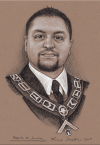
Roberto M. Sanchez is a very active Freemason. He served as Worshipful Master of his Mother Lodge - Gray Lodge No. 329 in 2011-2012, and as District Deputy Grand Master for the Grand Lodge of Texas in 2013.
In 2013-2014, he served as President of the Master's, Warden's and Secretaries Association of the 30th District in Houston, Texas as well as serving as Worshipful Master of St Albans' Lodge No 1455 a Traditional Observance Lodge in College Station, Texas.
He also served as Secretary of Gray Lodge No. 329 for many years. Roberto is a member of several Grand Jurisdictions, including the Grand Lodge of the State of Mexico where he holds the title and distinction as Past Grand Master, as well as serving as the Grand Ambassador of International Relations for that Grand Lodge.
Roberto is a member of the Houston Scottish Rite where he is a 32° (K.C.C.H.) Knight Commander of the Court of Honor; and served as Commander for the Houston Council of Kadosh in 2014. In 2009, 2011 and 2013 he was aid to the Sovereign Grand Commander, Ronald A. Seal, during the Supreme Council session.
Roberto is also a member of the York Rite, where he has served as presiding officer of Washington Chapter No. 2 R.A.M., Houston Council No. 1 R.&S.M. and Ruthven Commandery No. 2.
As a result he was invited into the Knight York Cross of Honor (K.Y.C.H.) Roberto is also a member of Chinar Grotto M.O.V.P.E.R. where he served as Monarch, the presiding officer in 2013, and is also a Past Grand Tall Cedar of Mexico Forest of the Tall Cedars of Lebanon.
For his dedication to the Craft, Roberto has been invited to several honorary and invitational bodies such as: The Societas Rosicruciana in Civitatibus Foederatis (SRICF), where he is currently the Celebrant for Stella Sola College in Texas and Herald for the National High Council of the S.R.I.C.F. Sam Houston Council Allied Masonic Degrees No. 275 where he served as Sovereign Master in 2013 and is currently serving the Grand Council as the Superintendent for Texas-South. Gulf Coast York Rite College No. 106 where he served as Governor in 2019-2020.
Lone Star Chapel No. 5 Commemorative Order of St. Thomas of Acon where he served as Worthy Master in 2019-2021, and is currently the Assistant Grand Marshal for the Province of South America. Anson Jones Council of Knight Masons No. 47 where he served as Excellent Chief in 2016.
In 2017, he was awarded the Knight Commander of Zerubbabel by the Grand Council of Knight Masons USA. He also belongs to the Royal Order of Scotland, Holy Royal Arch Knight Templar Priest, the Grand College of Rites, Order of Athelstan, Ypres Prefecture of the C.B.C.S. under the Great Priory of Belgium and several other bodies across Europe, North & South America.
Roberto has given lectures on Masonry all over the United States, Latin America, Canada and Europe.
Because of his love for history and Masonic research, Roberto joined Texas Lodge of Research, where he has submitted various papers and therefore was elected as a full member and served as Junior Warden.
Roberto served on the Board of Directors for the Masonic Building Association of Holland Lodge No 1. He is also the original Curator, Historian and Librarian for the Houston Masonic Library Museum as well as serving on the Board of Directors and Executive Committee.
He is the author of The True Masonic Experience, A Guide to the Ceremonial, and several other books.

The True Masonic Experience
By: Roberto M. Sanchez
The purpose of this book is to allow Freemasons, new and old an opportunity to learn and experience some of the practices that have fallen out of custom in our lodges.
We have gotten away from what our forefathers originally intended, and have become satisfied with the mediocre fellowship endured over a spaghetti dinner on paper plates.
We owe it to our members to give them Masonry, which is what they are asking for.
Since you are going to give them that, why not make it the best experience possible, why not give them The True Masonic Experience.
Recent Articles: symbolism
 Legends and Symbols in Masonic Instruction Explore the significance of Masonic legends and symbols in this insightful post. Discover how Freemasonry imparts wisdom through allegorical narratives and emblematic imagery, revealing profound moral and philosophical lessons. Unveil the deep connections between Masonic teachings and the broader quest for understanding life’s fundamental questions. |
 Discover the mystical significance of the number 33. From its mathematical marvels and artistic influence in numerology to its esteemed place in Freemasonry, delve into the history and power of this master number. Explore why 33 holds such profound meaning in various spiritual and philosophical traditions. |
 The Practice of Freemasonry - P1 Embark on a transformative journey with Freemasonry, where the exploration of your Center unlocks the Perfect Ashlar within. Through the practices of Brotherly Love, Relief, Truth, and Cardinal Virtues, discover a path of enlightenment and self-improvement. Embrace the universal creed that binds us in the pursuit of our true essence. |
 Discover the fascinating history and significance of the Warrant of Constitution within Freemasonry. Unveil the evolution of this crucial authorization, its role in legitimizing Lodges, and its lasting impact on the global brotherhood of Freemasons. Explore the intricate link it provides between tradition and modern practice. |
 Freemasonry: Unravelling the Complexity of an Influential Organization Mysterious and captivating, Freemasonry has piqued the interest of seekers and skeptics alike. With its intricate blend of politics, esotericism, science, and religion, this enigmatic organization has left an indelible mark on society. Prepare to delve into the secrets of Freemasonry and unlock its hidden depths. |
 Unlocking the Mysteries of Freemasonry: In the hallowed halls of Freemasonry, a powerful symbol lies at the heart of ancient rituals and teachings—the Volume of the Sacred Law. This sacred book not only guides the spiritual and moral journey of Freemasons but also serves as a beacon of universal wisdom and enlightenment. |
 The Ancient Liberal Arts in Freemasonry Embark on a journey of self-improvement and wisdom with Freemasonry's guiding principles. Ascend the winding stairs of moral cultivation, analytical reasoning, and philosophical understanding. Embrace arithmetic's mystical properties and geometry's universal truths. Let the harmony of the universe inspire unity and growth. Discover the profound, hidden knowledge in Freemasonry's path to enlightenment. |
 Initiation rituals around the world are filled with fascinating elements and different images. One of them is that of darkness. When societies speak of darkness, they often mean a lack of knowledge, a lack of choice, or a symbol of evil. During initiation rituals, darkness is used to represent the initiate's lack of knowledge about the world, society, and initiation in general. It can also represent the initiate's inability to make a choice or endure a situation. Whether you have participated in an initiation rite or not, the meaning of darkness remains an intriguing concept worth exploring. Initiation rituals around the world are filled with fascinating elements and different images. One of them is that of darkness. When societies speak of darkness, they often mean a lack of knowledge, a lack of choice, or a symbol of evil. During initiation rituals, darkness is used to represent the initiate's lack of knowledge about the world, society, and initiation in general. It can also represent the initiate's inability to make a choice or endure a situation. Whether you have participated in an initiation rite or not, the meaning of darkness remains an intriguing concept worth exploring. |
 Masonic Deacon rods potentially trace their origins to Greek antiquity, symbolically linked to Hermes' caduceus. As Hermes bridged gods and mortals with messages, so do Masonic Deacons within the lodge, reinforcing their roles through ancient emblems. This connection underscores a profound narrative, weaving the fabric of Masonic rites with the threads of mythological heritage, suggesting the rods are not mere tools but bearers of deeper, sacred meanings that resonate with the guardianship and communicative essence of their divine counterpart, Hermes, reflecting a timeless lineage from myth to Masonic tradition. |
 The biblical pillars erected by Solomon at the Temple's porch, hold a profound place in history. These brass behemoths are not mere decorations; they are symbols of strength, establishment, and divine guidance. Explore their fascinating construction, dimensions, and the deep meanings they carry in both biblical and Masonic contexts. |
 Unlocking the Mind's Potential: Dive deep into ground breaking research revealing how simple daily habits can supercharge cognitive abilities. Discover the untapped power within and redefine your limits. Join us on this enlightening journey and transform your world! |
 Dive deep into the symbolic importance of the trowel in Masonry, representing unity and brotherly love. From its historical roots in operative masonry to its significance in speculative masonry, this article explores the trowel's multifaceted role. Discover its connection to the sword, the story of Nehemiah, and the Society of the Trowel in Renaissance Florence. Unravel the layers of meaning behind this enduring Masonic symbol. |
 Symbolism of The Builder's Jewel Batty Langley's "The Builder’s Jewel" (1741) is a visual masterpiece of Masonic symbolism, showcasing Langley's deep understanding of Freemasonry. The frontispiece highlights key symbols like the three pillars and the legend of Hiram Abiff, emphasizing Langley's dedication to Masonic traditions and teachings. |
 Unveil the mystique of the colour blue in Masonic symbolism. A hue evoking universal friendship and benevolence, its roots span ancient cultures, infusing Freemasonry's core values. This article explores blue's profound significance, guiding Freemasons towards wisdom and spiritual enlightenment. Discover the fascinating journey of this universal symbol. |
 Discover the intriguing world of the plumb in Masonic symbolism with our in-depth analysis. Uncover its rich history, moral teachings, and significance in Freemasonry, guiding members on their path to truth, integrity, and justice. Immerse yourself in the captivating power of this symbol that shapes lives within the brotherhood. |
 Unlock the mysteries of Freemasonry with 'The Key,' a profound Masonic symbol. This seemingly simple instrument holds a deeper meaning, teaching virtues of silence and integrity. Explore its ancient roots, from Sophocles to the mysteries of Isis, and discover how it symbolizes the opening of the heart for judgment. |
 Unlock the secrets of the Freemasonry with The Blazing Star - a symbol that holds immense significance in their rituals and practices. Delve into its history, meaning and role in the different degrees of Freemasonry with expert insights from the Encyclopedia of Freemasonry by Albert Mackey. Discover the mystique of The Blazing Star today! |
 There is no symbol more significant in its meaning, more versatile in its application, or more pervasive throughout the entire Freemasonry system than the triangle. Therefore, an examination of it cannot fail to be interesting to a Masonic student. Extract from Encyclopedia of Freemasonry by Albert Mackey |
 The Hiramic Legend and the Myth of Osiris Hiram Abiff, the chief architect of Solomon’s Temple, is a figure of great importance to Craft Freemasonry, as its legend serves as the foundation of the Third Degree or that of a Master Mason. He is the central figure of an allegory that has the role of teaching the Initiate valuable alchemical lessons. Although his legend is anchored in biblical times, it may have much older roots. |
 This rite of investiture, or the placing upon the aspirant some garment, as an indication of his appropriate preparation for the ceremonies in which he was about to engage, prevailed in all the ancient initiations. Extract from The Symbolism of Freemasonry by Albert G. Mackey |
 The All-Seeing Eye of God, also known as the Eye of Providence, is a representation of the divine providence in which the eye of God watches over humanity. It frequently portrays an eye that is enclosed in a triangle and surrounded by rays of light or splendour. |
 What's in a Word, Sign or Token? Why do Freemasons use passwords, signs, and tokens? As Freemasons we know and understand the passwords, signs and tokens (including grips), which are all used a mode of recognition between members of the fraternity. |
 A Temple of Living Stones: Examining the Concept of a Chain of Union What are the origins of the Chain of Union? And how did they come about ? The answers may surprise some members as W Brother Andrew Hammer investigates, author of Observing the Craft: The Pursuit of Excellence in Masonic Labour and Observance. |
 One of the best loved stories for the festive season is ‘A Christmas Carol’. A traditional ghost story for retelling around the fire on a cold Christmas Eve, it is a timeless classic beloved by those from all walks of life. Philippa explores the masonic allegory connections… |
 The Trowel - Working Tool of the Master Mason The Trowel is the symbol of that which has power to bind men together – the cement is brotherhood and fellowship. |
 Two Perpendicular Parallel Lines The point within a circle embordered by two perpendicular parallel lines, with the Holy Bible resting on the circle, is one of the most recognizable symbols in Freemasonry. It is also one which always raises a question. How can two lines be both perpendicular and parallel? |
 "The first great duty, not only of every lodge, but of every Mason, is to see that the landmarks of the Order shall never be impaired." — Albert Mackey (1856) |
 It is common knowledge that the ancient wages of a Fellowcraft Mason consisted of corn, wine, and oil. |
 “Do not come any closer,” God said. “Take off your sandals, for the place where you are standing is holy ground.” Exodus 3:5 |
 The Secret Language of the Stone Masons We know of Masons' Marks but lesser known are the 'argots' used by the artisans - in part 2 of a series on the social history of the Operative Masons we learn how the use of secret languages added to the mystery of the Guilds. |
 The phrase appears in the Regius Poem. It is customary in contemporary English to end prayers with a hearty “Amen,” a word meaning “So be it.” It is a Latin word derived from the Hebrew word - Short Talk Bulletin - Vol. V June, 1927, No.6 |
 Egypt's 'Place of Truth' - The First Operative Stone Masons' Guild? Was ancient Egypt's 'village of the artisans' the first operative stone masons' guild? And was their use of 'identity marks' a forerunner of the Mason's Marks of the cathedral builders of the Middle Ages? Read on for some possible answers… |
 The Pieces of Architecture and the Origin of Masonic Study Discover the journey of the Apprentice – from Operative to Speculative. This journey has been carried out since the times of operative Freemasonry but today the initiate works in the construction of his inner temple. |
 The Builders' Rites - laying the foundations operatively and speculatively The cornerstone (also ‘foundation’ or ‘setting’ stone) is the first stone to be set in the construction of the foundations of a building; every other stone is set in reference to this. |
 Applying the working tools to achieve our peculiar system of morality. |
 We take an in-depth look at the 47th Proposition of the 1st Book of Euclid as part of the jewel of the Past Master. |
 The Cable Tow: Its Origins, Symbolism, & Significance for Freemasons - Unbinding the significance of the cable tow. |
 We examine at one of the most impressive moments of the initiatory ceremony, a certain rite known as Circumambulation, and ask what is its meaning and purpose ? |
 So, what is the Level? And why do we use it in Freemasonry? |
 What is the mysterious pigpen or Masonic cipher that has been used for centuries to hide secrets and rituals? |
 The Story of the Royal Arch - The Mark Degree Extracted from William Harvey's 'The Story of the Royal Arch' - Part 1 describes the Mark Degree, including the Working Tools. |
 Ashlars - Rough, Smooth - Story of a Stone How we can apply the rough and smooth Ashlars with-in a masonic context |
 A detailed look at the Chamber of Reflection: A Revitalized and Misunderstood Masonic Practice. |
 Exploring the origin and symbolism of Faith, Hope and Charity |
 The Noachite Legend and the Craft What is it to be a true Noachidae, and what is the Noachite Legend and the Craft ? |
 In Masonic rituals, Jacob’s ladder is understood as a stairway, a passage from this world to the Heavens. |
 What is the meaning of the Acacia and where did it originate ? |
 What is the connection with the Feasts of St John and Freemasonry |
 The Forget-Me-Not and the Poppy - two symbols to remind us to 'never forget' those who died during the two World Wars. |
 Biblical history surrounding the two pillars that stood at the entrance to King Solomon's Temple |
 Is there a direct link between Judaism and Freemasonry? |
 The symbolism of the beehive in Masonry and its association with omphalos stones and the sacred feminine. |
 The Wages of an Entered Apprentice |
 An explanation of the North East corner charge which explores beyond one meaning Charity - |
 A brief look at the origins of the two headed eagle, probably the most ornamental and most ostentatious feature of the Supreme Council 33rd Degree Ancient and Accepted (Scottish ) Rite |
 A Muslim is reminded of his universal duties just as a Freemason. A Masonic Interpretation of the Quran's First Two Chapters |
 The three Latin words -{Listen, Observe, Be Silent}. A good moto for the wise freemason |
masonic knowledge
to be a better citizen of the world
share the square with two brothers

click image to open email app on mobile device


